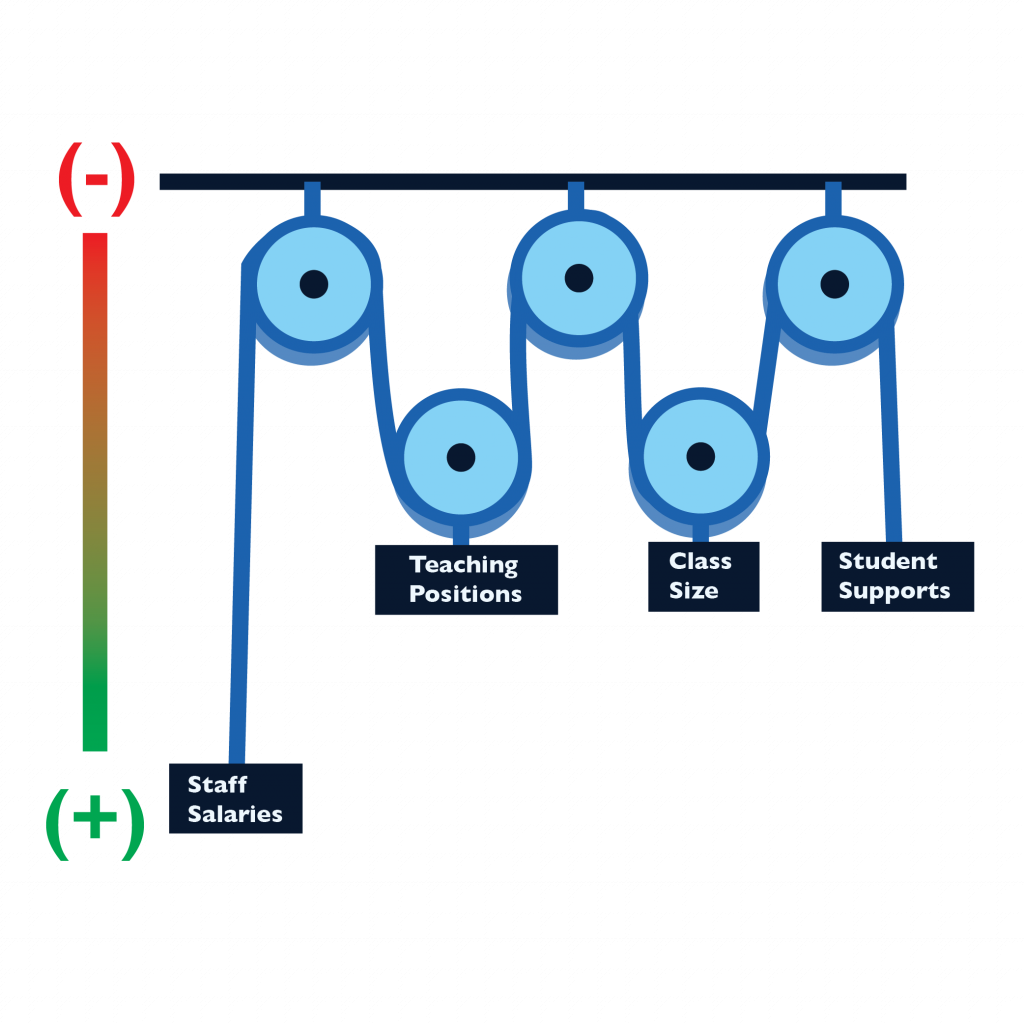I often tell school board members through the strategic planning process they can do anything they want as a school district, just not everything. It is the time of the year when school boards should be taking stock of progress made on their strategic plan priorities and discussing with the district leadership team what the next steps are for accomplishing their long-term goals. As boards make decisions on staffing, salaries, facilities and more, the ultimate goal is to ensure that every child is on a path toward success. That is why it is so important boards get their work right.
Together, let’s explore the basics of budgeting for your district focused on student success. KASB staff are always available to help your board leadership team through school finance, budgeting, and goal setting.
Resource allocation and the annual budgeting process
Resource allocation is one of the critical levers that school board members use to align the school district to the vision established by the board of education. Resource allocation occurs during the development of the school district's annual budget.
 Alignment of resources with the defined vision can only happen for school boards when there is agreement on the vision and diligence by the board to learn about current realities related to successes, barriers, and next steps in making the vision a reality. This learning for the board must occur throughout the year, not just in the budget development process. The steps outlined below serve as actions and reminders for board members going through the budgeting process.
Alignment of resources with the defined vision can only happen for school boards when there is agreement on the vision and diligence by the board to learn about current realities related to successes, barriers, and next steps in making the vision a reality. This learning for the board must occur throughout the year, not just in the budget development process. The steps outlined below serve as actions and reminders for board members going through the budgeting process.
The annual budgeting process for a school board reflects the short-term priorities to accomplish long-term goals. Over a budget year, school boards should be taking stock of progress and alignment from the "watchtower" perspective. Accountability to the established long-term goals comes from critical questions that get asked by the school board. When open communication is happening around the board table, school board members understand how every decision connects to other pieces of the school district.
The past year, I worked with a community group studying their school district, and I explained the budgeting prioritization process by giving the visual of a series of pulleys. When you pull on one, it will impact the others. In terms of school budgeting, the impact on the other pulleys means a change in resources.
When school boards reflect on the system's priorities, they must also consider the implications when putting resources into different priorities. Each of the letters above represents a different priority in the diagram above. The more resources poured into any given area, the more significant the impact on the others. Some examples of priorities that boards must consider:
 Competitive teacher salaries
Competitive teacher salaries
Raises that a board can offer are impacted by the number of teaching positions within the school district. The more teaching positions, the more cost to the entire system to give a raise, versus lessening the total number of teachers frees up resources for the raises. However, this will potentially impact class sizes or support offered to students.
Number of Buildings within School District
Boards often face the dilemma of maintaining the current number of buildings versus closing or opening additional buildings. Prioritizing these types of facility decisions has many moving parts to consider; staffing efficiency, courses and student support offerings, the proximity of schools to students and families, resources for facility improvement and maintenance
Changing the school start time
The decision to flip the high school start time to 8:30 and move the elementary to 7:30 because research indicates it would be best for students' ages and development. The parts of the system impacted include transportation routes, before and after school activities or support for families and students, the impact of junior and senior high activities, and missed school
The above scenarios are just a few that boards grapple with as they work towards their long-term goals of a school district. School board members should approach these decisions with a curiosity and willingness to learn about the implications of prioritizing one area over another in the budget process. There are two parts of accountability when building the budget: following the legal requirements and aligning resources to long-term goals. Meeting the legal obligations is the role of the superintendent and district administration, and the school board ensures alignment with the long-term goals.
Effectively executing the budgeting process is much simpler if there is universal agreement and an understanding of the long-term goals with the entire school board. Seizing on opportunities beyond regular board meetings to learn from each other and discuss common work deepens the school board's understanding of how their decisions on budgeting impact long-term goals and improves overall communication. That deeper understanding and enhanced communication translates to greater accountability for long-term goals from the school board.
One of the most significant areas of anxiety for new board members is the budgeting process. The incumbent board members become frustrated or agitated when the new board member asks why these are the priorities. After an election, school boards should inform their new board members about how they arrived at those adopted long-term goals and progress on the plans. I am not suggesting that a board change direction after each election based on who gets elected and their preferences. The newly formed board must take time to explain the process used to develop the long-term goals, the rationale for these, and the progress made. Describing how the utilization of needs assessments and stakeholder input assists in establishing long-term priorities ensures alignment to the broad needs of the school district and can assist new board members with understanding what the focus has been and why.
The physical act of building the budget is an exact science. KSDE works directly with your superintendent and administrative team to update them on changes in the law and methods to be compliant. The art of building the budget happens around the board table when the school board has an agreed-upon vision, long-term goals to work toward that vision, and discussion about progress and alignment of the system to the vision.
Your community elected you to set budget priorities based on your students’ needs. With careful and consistent planning focused on student success, your district budget can thrive.

 Additional settings for Safari Browser.
Additional settings for Safari Browser.



 Alignment of resources with the defined vision can only happen for school boards when there is agreement on the vision and diligence by the board to learn about current realities related to successes, barriers, and next steps in making the vision a reality. This learning for the board must occur throughout the year, not just in the budget development process. The steps outlined below serve as actions and reminders for board members going through the budgeting process.
Alignment of resources with the defined vision can only happen for school boards when there is agreement on the vision and diligence by the board to learn about current realities related to successes, barriers, and next steps in making the vision a reality. This learning for the board must occur throughout the year, not just in the budget development process. The steps outlined below serve as actions and reminders for board members going through the budgeting process.  Competitive teacher salaries
Competitive teacher salaries